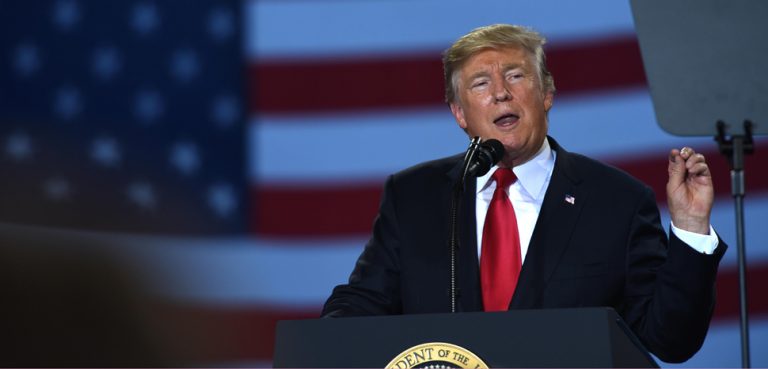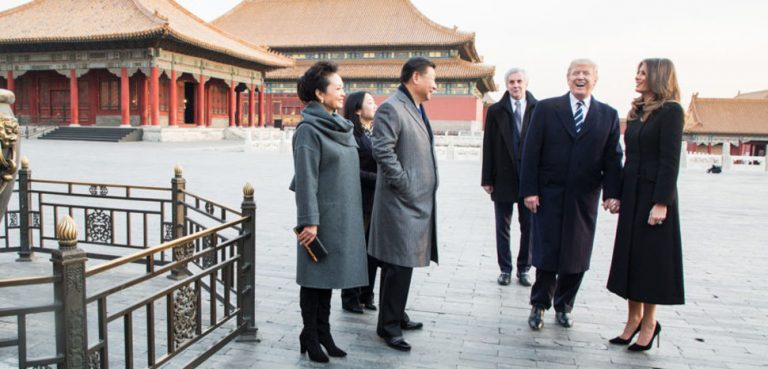Donald Trump has doubled down in response to rising Democratic star Beto O’Rourke’s first outings on the campaign trail. The president has tried to paint his Texan challenger as a frenzied flake—and has renewed his aggressive trade strategy toward China, a key theme of one of O’Rourke’s recent stump speeches.
To begin with, both Trump and Beto agree that criticisms of China’s trade policy are well-founded. China has been drastically overproducing commodities like steel and aluminum for years, using vast state subsidies to stimulate its metals industries. Excess production accounted for 21% of China’s entire domestic demand for steel in 2016.
Several other countries have accused China of dumping excess metal on international markets, lowering global prices in the process. Just look at the aluminum sector, where a dramatic spike in Chinese output has brought prices crashing down and caused several countries, including the U.K., to practically shut down production altogether.
But where Beto takes a different tack is how to rein in China. Referring to Trump’s tactic of imposing draconian unilateral tariffs, the Texas hopeful argued: “we want him to be successful in this, but […] when have we ever gone to war, including a trade war, without allies?” The president would be wise to consider his rival’s comments when talks with Beijing continue this week – rather than resorting to his usual brand of defiance and deflection.
Pain on both sides
Beto’s comments eschewed the traditional line of criticism of the trade war—that the tariffs are hurting the U.S. more than they are China. The tariffs have certainly brought pain to American consumers: economists estimate the trade war shaved $7.8 billion off U.S. GDP in 2018, while higher import charges have cost American consumers and producers nearly $70 billion. But the trade war has hit China hard, too. Beijing’s annual exports dropped 20%, the sharpest decline in three years. Unemployment hit a two-year high and the markets have notched their worst performance in a decade. High-level officials including premier Li Keqiang have been forced into a rare admission that the Chinese economy is softening.
Trump may be right to point out that China’s dumping is destabilizing global markets— but he could, and should, have chosen a different path: attempting multilateral action and tapping into Washington’s traditional alliances to corner China.
For instance, metals industry bodies around the world have already united to condemn Beijing, and their fury is increasingly reflected at government level. The G20 has committed to curbing excess steel supply, and the EU has taken action to stem the tide of Chinese metals. Had Trump urged the international community to join forces, he’d have received a receptive response.
The White House instead pushed for a mano a mano fight with China, alienating America’s partners in the process. In a bitter irony, the sweeping tariffs Trump imposed on steel and aluminum have hurt American allies like Canada far more than they have wounded Beijing. The U.S. has granted a scant three of Canada’s requests to be excluded from the aluminum tariffs, while Washington has approved 108 of China’s exclusion requests. Essentially, China has been allowed to export almost as much aluminum to the States as it did in 2017.
WTO crucial to checking Chinese dumping
Not only has Trump’s decision to go it alone harmed traditional U.S. allies, it runs the risk of dangerously destabilizing the World Trade Organization (WTO), which—despite Trump’s protests that the organization is “unfair”—plays a pivotal role in maintaining the fairness of trade flows around the world. The WTO provides an independent method of resolving disputes that is less disruptive than tit-for-tat trade wars and prevents trade from being “used as a political weapon by great powers to reward friends and punish enemies.” And Washington played the starring role in defining the rules of the global trade system, the WTO, and the GATT before it.
Despite the WTO’s benefits, it’s clear that China has taken advantage of the bloc’s trade rules since it joined in 2001. Though Beijing was forced to accept more stringent conditions than any other WTO member, it has still managed to use the WTO’s “special and differential treatment” clause for developing nations to justify trade-distorting subsidies— few of which it discloses. The WTO evidently needs a more effective mechanism to tackle this undeclared aid, such as a 2018 proposal to implement targeted remedies against unlawful subsidies, including a scheme of escalating administrative sanctions.
Even aside from the WTO reforms which the U.S. and its allies could push for, there remains more room within the organization’s existing framework to tackle Chinese overcapacity and subsidies. Though China is far from full compliance, it has indeed made progress in response to complaints through the WTO’s dispute settlement procedure. By working with its partners to tighten the WTO rules and trying to engage China in multilateral negotiations, the U.S. could substantially increase this rate of compliance and address the genuine issues of Chinese overcapacity and support for state-owned enterprises without the negative effects of a trade war.
Final stages
With Liu He, China’s top trade negotiator, set to visit Washington this week, analysts are hopeful that an end to the trade dispute is in sight, with both sides reportedly keen to do a deal. But significant obstacles remain, notably Beijing’s continued frustration at Trump’s erratic negotiating tactics.
If Trump can seal a deal with Beijing, it could provide the ideal fillip as he kick-starts his re-election campaign. But, to do so, he may have to take the advice of one of his top Democratic rivals and engage with Washington’s traditional allies, rather than allowing them to become collateral damage.
The views expressed in this article are those of the authors alone and do not necessarily reflect those of Geopoliticalmonitor.com or any institutions with which the authors are associated.




